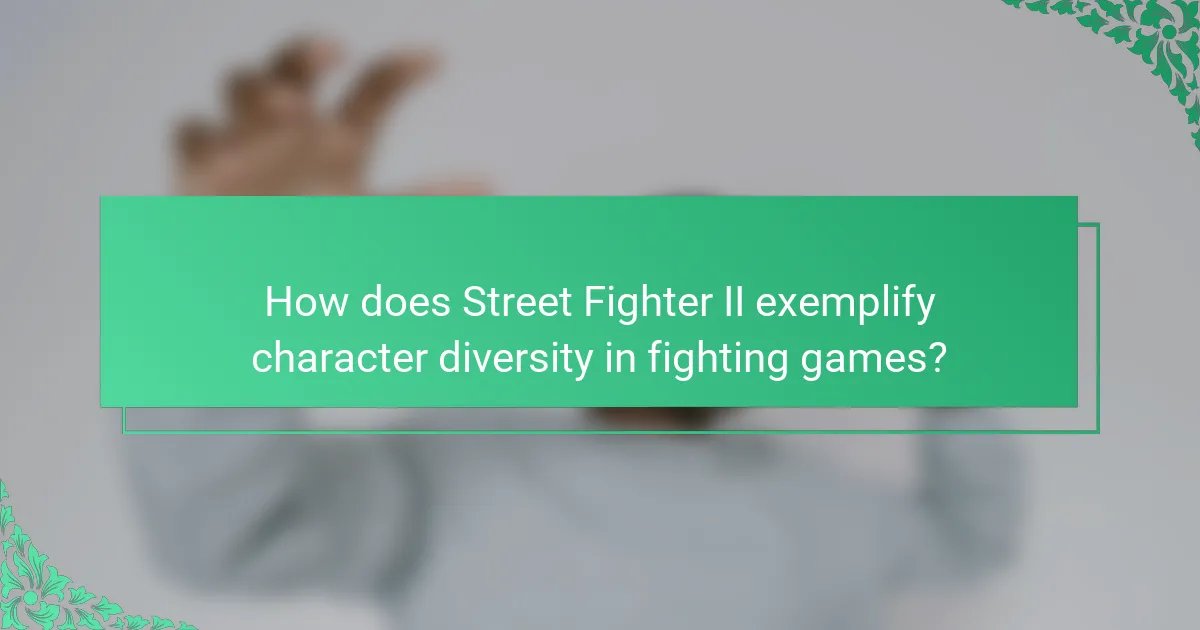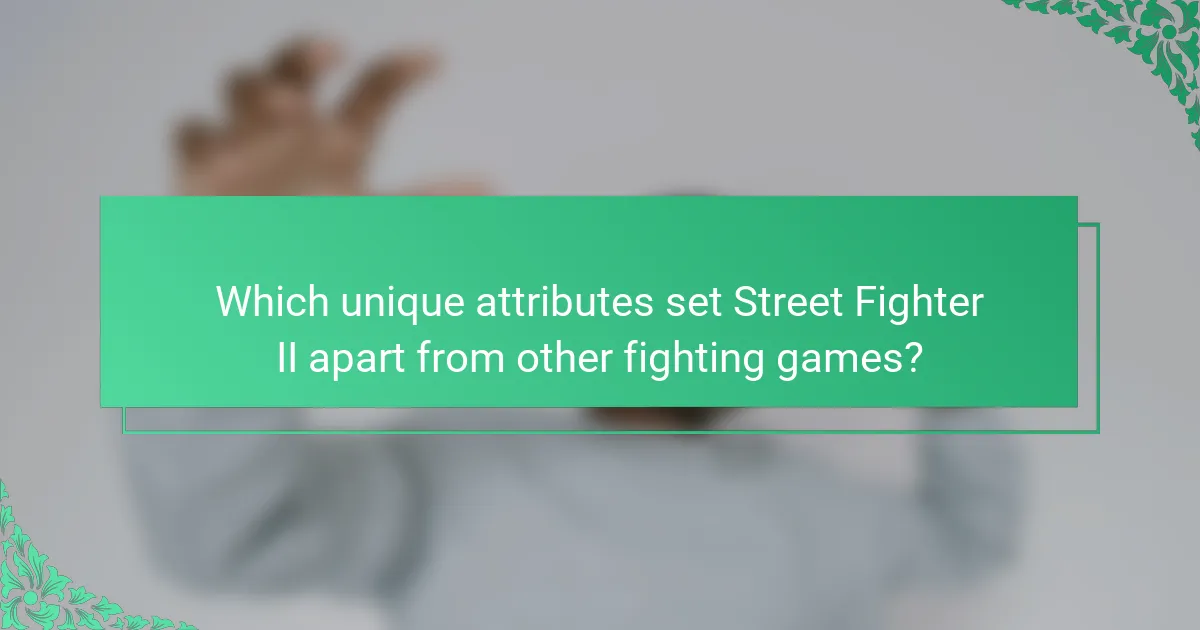Street Fighter II revolutionized fighting games with its diverse character roster and competitive gameplay. The game features 16 unique fighters, each with distinct abilities and styles. Character diversity enhances strategic depth in competitive play, driving players to adapt their strategies. Its influence on future titles is evident through established standards in character design and community engagement.

How does Street Fighter II exemplify character diversity in fighting games?
Street Fighter II exemplifies character diversity through its varied fighting styles, backgrounds, and abilities. The game features 16 characters, each with unique attributes and fighting techniques, appealing to different player preferences. This diversity fosters competitive play by allowing players to choose characters that align with their strategies. For instance, Ryu represents a balanced fighter, while Chun-Li offers speed and agility. The game’s influence on the genre is evident, as it set a standard for character selection and representation in future fighting games.
What are the key character archetypes in Street Fighter II?
The key character archetypes in Street Fighter II include the Shoto, the Grappler, the Zoner, the Rushdown, the Charge, and the Hybrid. Each archetype represents distinct playstyles and strategies.
Shoto characters, like Ryu and Ken, focus on balanced abilities and projectile attacks. Grapplers, such as Zangief, excel in close-range combat and throws. Zoners, like Dhalsim, control space with long-range attacks. Rushdown characters, exemplified by Chun-Li, emphasize aggressive, fast-paced offense. Charge characters, like Guile, require specific input timing for powerful moves. Hybrids, such as Cammy, combine traits from multiple archetypes for versatile gameplay.
These archetypes showcase the diversity and strategic depth that define competitive play in Street Fighter II.
How do character abilities influence gameplay strategies?
Character abilities significantly shape gameplay strategies in Street Fighter II by influencing player choices and tactics. Each character possesses unique strengths and weaknesses, compelling players to adapt their strategies for effective competition. For instance, a character with high mobility may focus on quick attacks and evasive maneuvers, while a character with powerful combos might emphasize aggressive play. This diversity encourages players to explore various matchups, enhancing the game’s depth. As a result, understanding character abilities becomes essential for mastering competitive play in the evolving landscape of fighting games.
Which characters are considered iconic and why?
Iconic characters in Street Fighter II include Ryu, Chun-Li, and Ken due to their unique abilities and cultural impact. Ryu represents the essence of martial arts with his balanced fighting style. Chun-Li is celebrated for her agility and strength, becoming a symbol of female empowerment in gaming. Ken’s fiery moves and rivalry with Ryu add depth to the game’s narrative. These characters have evolved through various iterations, maintaining relevance in competitive play and influencing the fighting game genre. Their distinct attributes and iconic status contribute to the game’s legacy.
How does character selection vary among different player demographics?
Character selection in Street Fighter II varies significantly across player demographics. Younger players often gravitate towards characters with flashy moves, while older players may prefer those with deeper strategic elements.
Cultural background also influences choices; players from regions with strong martial arts traditions might select characters that reflect those styles. Competitive players tend to choose characters based on tier lists, favoring those deemed stronger in the meta.
Gender representation plays a role as well, with female characters attracting diverse player bases, especially among women. The evolution of fighting games has led to greater character diversity, allowing for broader appeal across demographics.

What role does competitive play have in the evolution of Street Fighter II?
Competitive play significantly shaped the evolution of Street Fighter II by driving character diversity and gameplay mechanics. The competitive scene encouraged players to explore various characters, leading to a balance of strengths and weaknesses among fighters. This diversity fostered strategic depth, as players adapted their play styles to exploit unique attributes. The game’s success in tournaments established a framework for future fighting games, emphasizing competitive integrity and community engagement. As a result, Street Fighter II set a standard for character design and competitive play in the genre.
How has the competitive scene shaped player interactions and community?
The competitive scene has fostered dynamic player interactions and a strong community. Character diversity in Street Fighter II encouraged players to develop unique strategies and foster rivalries. This competition led to the formation of local and global communities, where players share knowledge and skills. Additionally, the evolution of fighting games has created a culture of collaboration, with players often forming teams and participating in tournaments. The competitive landscape has also influenced the development of online platforms for communication and strategy sharing, further strengthening community ties.
What are the major tournaments featuring Street Fighter II?
Major tournaments featuring Street Fighter II include the Evolution Championship Series (EVO), the Capcom Cup, and the Japan Cup. These events showcase competitive play and highlight the game’s character diversity. EVO is renowned for its global participation, while the Capcom Cup focuses on top players from the franchise. The Japan Cup emphasizes regional talent and community engagement. Each tournament has shaped the evolution of fighting games through its unique attributes and competitive formats.
How do player skills and character choices impact tournament outcomes?
Player skills and character choices significantly influence tournament outcomes in Street Fighter II. High-level players often select characters that complement their playstyle and strengths, which can lead to strategic advantages.
Character diversity allows for unique matchups, where specific character attributes can counter opponents effectively. For instance, a character with strong zoning abilities can control space and limit aggressive tactics. Additionally, player skills, such as execution and decision-making, enhance the effectiveness of character choices during matches.
In competitive play, understanding character strengths and weaknesses is crucial. Some characters have rare attributes that can turn the tide of a match, such as unique special moves or frame advantages. Combining these factors determines the likelihood of success in tournaments.
Ultimately, the synergy between player skills and character selection shapes the competitive landscape of fighting games, highlighting the importance of both elements in achieving tournament success.

Which unique attributes set Street Fighter II apart from other fighting games?
Street Fighter II stands out due to its diverse character roster, strategic competitive play, and significant influence on the evolution of fighting games. The unique attributes include a variety of fighting styles, iconic special moves, and character backstories that enhance player engagement. The game introduced a competitive ranking system, fostering a community around skill-based play. Additionally, its innovative mechanics, like combo systems and unique character abilities, set a benchmark for future titles. These elements collectively define its lasting legacy in the gaming industry.
What innovative mechanics were introduced with Street Fighter II?
Street Fighter II introduced innovative mechanics like special moves, combo systems, and character selection. These features enhanced character diversity and competitive play, setting a new standard for fighting games. Special moves provided unique fighting styles for each character, while the combo system allowed players to string attacks together for greater damage. Character selection introduced distinct abilities and attributes, fostering strategic depth in gameplay. These innovations significantly influenced future fighting games, establishing a foundation for competitive gaming.
How did Street Fighter II influence the design of future fighting games?
Street Fighter II significantly influenced future fighting game design by introducing character diversity and competitive mechanics. Its roster featured unique characters with distinct fighting styles, promoting varied gameplay. This emphasis on character individuality set a precedent for subsequent games, encouraging developers to create diverse character lineups. Additionally, Street Fighter II popularized competitive play through its balanced mechanics and tournament culture, shaping how future fighting games approached competitive design. As a result, many games adopted similar structures, focusing on player skill and strategy.

What are the common challenges faced by players in competitive environments?
Players in competitive environments face several common challenges. These include character balance, player skill variation, and adaptation to evolving strategies.
Character diversity in Street Fighter II can lead to matchup imbalances, affecting competitiveness. Players must constantly adapt to different fighting styles and character strengths. Additionally, the pressure of high-stakes matches can impact performance, leading to stress and decision-making challenges.
As a result, players often invest significant time in practice and study to overcome these hurdles and improve their gameplay.
How do players adapt to different play styles and strategies?
Players adapt to different play styles and strategies by analyzing opponents, adjusting character selection, and modifying their techniques. Understanding character strengths and weaknesses enhances competitive performance. For instance, a player may switch from a rushdown character to a zoning character based on the opponent’s tactics. This flexibility is crucial in Street Fighter II, where diverse characters offer unique attributes, enabling varied gameplay. Adapting to strategies involves recognizing patterns and responding with counter-techniques, fostering a dynamic competitive environment.
What psychological factors influence competitive play in Street Fighter II?
Psychological factors influencing competitive play in Street Fighter II include player mindset, character attachment, and adaptability. A positive mindset enhances performance, while attachment to specific characters can affect decision-making. Adaptability is crucial for responding to opponents’ strategies. Understanding these factors can significantly impact gameplay outcomes.

How have community-driven initiatives impacted the longevity of Street Fighter II?
Community-driven initiatives have significantly enhanced the longevity of Street Fighter II by fostering engagement and competition. These initiatives include organized tournaments, online forums, and fan-created content that keep the game alive. Players continuously refine strategies and share insights, promoting a dynamic competitive environment. Additionally, community feedback has influenced game adaptations and remakes, ensuring relevance in modern gaming. The unique attribute of Street Fighter II’s character diversity further attracts new players, sustaining its popularity over decades.
What role do fan-made content and mods play in the game’s evolution?
Fan-made content and mods significantly enhance the evolution of Street Fighter II by introducing new gameplay mechanics and character diversity. These creations allow players to experiment with unique attributes, such as custom moves and balance adjustments, which can lead to a more dynamic competitive scene. Additionally, fan-made content fosters community engagement, encouraging collaboration and innovation among players. As a result, these contributions help keep the game relevant and continually evolving in response to player feedback and preferences.
How do online platforms facilitate community engagement and competition?
Online platforms enhance community engagement and competition in fighting games like Street Fighter II through interactive features and global connectivity. They enable players to connect, share strategies, and participate in tournaments. These platforms support diverse character choices, promoting unique playstyles and fostering a vibrant competitive environment. As a result, players experience a dynamic evolution of skills and tactics, reflecting the game’s rich history and character diversity.

What best practices can enhance performance in Street Fighter II?
To enhance performance in Street Fighter II, players should focus on mastering character strengths, practicing combos, and understanding matchups. Character diversity allows players to exploit unique abilities and adapt strategies. Consistent practice improves execution speed and reaction time. Analyzing competitive play helps identify effective tactics and counter-strategies. Engaging with the community fosters learning and skill development.
How can players improve their skills through practice and analysis?
Players can enhance their skills through consistent practice and detailed analysis of their gameplay. Regularly playing Street Fighter II helps players understand character diversity and develop strategies. Analyzing matches allows players to identify strengths and weaknesses, improving decision-making and execution.
Practicing specific combos and techniques fosters muscle memory, while reviewing gameplay footage enables players to spot mistakes and refine their tactics. Engaging with the community provides insights into competitive play and evolving strategies. This holistic approach leads to continuous improvement and adaptation in a dynamic gaming environment.
What strategies should players adopt for character mastery?
Players should adopt strategies focused on practice, character knowledge, and adaptability for character mastery. Mastering a character in Street Fighter II requires consistent practice to understand their moves and combos. Knowledge of each character’s strengths and weaknesses enhances competitive play. Players should also adapt their strategies based on opponents’ styles, enabling effective counterplay. Additionally, studying match footage can provide insights into advanced techniques and tactics. Engaging with the community for tips and strategies can further enhance mastery.


